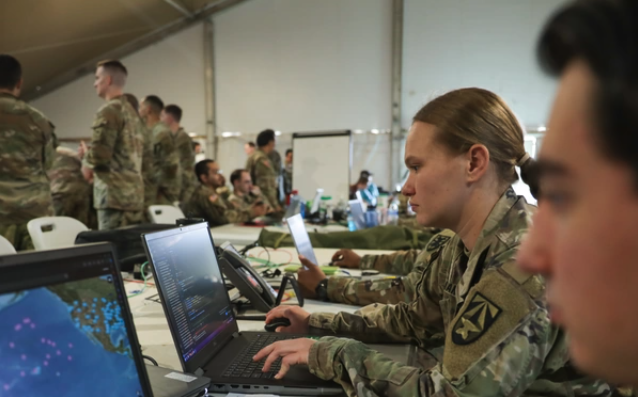What’s next for the US military’s Global Information Dominance Experiments

In the next few Global Information Dominance Experiments (GIDE) set to unfold this year, Pentagon personnel plan to expand data-sharing and integration among U.S. allies and continue to develop a new “methodology of rapid learning” to inform how the military adopts emerging and advanced technologies, according to a senior official.
Early iterations of the GIDE series launched around 2020 and were facilitated by the Northern American Aerospace Defense Command and U.S. Northern Command. But in 2022, Deputy Defense Secretary Kathleen Hicks tasked the Chief Digital and Artificial Intelligence Office with revamping the initiative to strategically test out and enable capabilities that could help realize the U.S. military’s nascent Joint All-Domain Command and Control warfighting construct. The plan was to conduct experiments every 90 days.
Col. Matthew Strohmeyer, the office’s division chief for JADC2 experimentation, has played a key role in the GIDE series throughout its evolution.
During a virtual panel hosted by the Center for Strategic and International Studies on Tuesday, Strohmeyer spotlighted some of the Defense Department’s progress and challenges that have been driven by GIDE to date — and particularly in the ninth iteration of the series, which concluded last week in conjunction with the Army’s latest Project Convergence activities.
In an exclusive interview after the CSIS event, Strohmeyer briefed DefenseScoop on his team’s vision for the next three events in the pipeline over 2024 — dubbed GIDE 10, 11 and 12.
“We have three mission threads this year inside GIDE,” he told DefenseScoop. The first is what his team has dubbed “global integration.”
“This is trying to integrate the combatant commands and the Joint Staff — globally, digitally, and the decisions that we make — and really connect that to have better and faster decisions,” he explained.
The second mission thread is “joint kill chains.”
“We want to close kill chains better, faster and in a joint way — not in a service-specific way,” Strohmeyer said.
“And then the third mission thread for us this year, which is new, is ‘allied and partner integration.’ We’d actually worked on that some last year, but it’s been kind of like a side effort. But it’s so critical to what we do that, we integrate all of our allies and our partners — not just like integrating [Microsoft] Word, or text. I’m talking about digitally integrating them with what we’re doing, which becomes so very difficult when it comes to these classified networks … Getting out after that in a real tangible way is a really important one,” he added.
The aim there is to deepen data- and AI-aligned cooperation with the United States’ Five Eyes partners — which include Canada, Australia, New Zealand and the U.K. — and others.
Although GIDE 9 just completed, the tenth iteration of the series is scheduled in about four weeks — notably sooner than the usual 90-day interlude between events.
“It just so happens that it overlaps on top of a couple of other big exercises, which is why it has to happen only four weeks later. But GIDE 10 is going to get after, actually, all three of those mission threads. So, it’s a really major event for us. It’s going to be partnered with the Joint Staff and the combatant commands to get after global integration at scale in a much bigger way,” Strohmeyer said.
The upcoming experiments will include multiple participants from each of the 11 combatant commands.
“GIDE 10 is happening across the globe at all the different combatant commands and the Pentagon,” Strohmeyer noted.
“It’s essentially taking the work that we did in the past GIDEs and starting to bring it to scale, which gets us to the point of — we’re not doing experimentation for the sake of experimentation, we’re doing it for the sake of actually fielding capability,” he added.
Beyond further refining the CDAO’s minimum viable capability for JADC2 that was generated over the past few events in the experimentation series, GIDE 10 will also involve what Strohmeyer referred to as “on the joint fires side, getting ready for GIDE 11.”
Scheduled for the June 2024 time frame, GIDE 11 will align with — and deliver capabilities for — Indo-Pacific Command’s next Valiant Shield exercise, where the military expects to conduct a real-time test of its Joint Fires Network prototype.
When asked about plans for GIDE 12, Strohmeyer said that’s to be determined. They’ll be shaped by what happens in the two events that come next.
“What we thought we were going to do at the beginning of last year did not look quite like what we did at the end of the year, because we learned as we went — so we’re going to be doing that same thing,” Strohmeyer explained.
In that sense, his team is pretty confident that they have developed what he called “a methodology of rapid learning for the Department of Defense, by using this new approach.”
“I can predict with probably about 80 to 90% accuracy what we’re going to do in GIDE 10, just four weeks away. But maybe it’s about 60% accuracy [to predict] what we’re going to do in GIDE 11, and like 40% accuracy what we’re going to do in GIDE 12 at the end of the year — because we’re just going to learn as we go. But it’s a little bit challenging for the department because we’re used to having very tightly codified requirements,” Strohmeyer told DefenseScoop.



